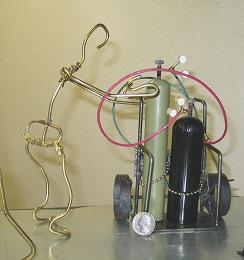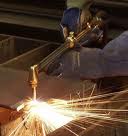|
OXY-ACETYLENE INFORMATION THAT WILL HELP YOU WORK SMART AND NOT GET BURNED UPOXY-ACETYLENE, When I first went to welding school and I had to light the OXY-ACETYLENE torch, I was scared to death . What the h@ll was I thinking ? I had never even really been around tools much, let alone, Tools that shot fire out of them !!! "RUN" I TOLD MYSELF :0... but I didn't, I stayed, I stayed because it was a huge adrenaline rush for me. I loved it !!! The video below is a perfect example of a new welder student starting out . He does't have any safety gear on so" PLEASE DO NOT DO THIS" !!! THIS IS THE GEAR YOU SHOULD WEAR WHEN WELDING OR CUTTING
Oxy-acetylene or (Oxyfuel) cutting uses acetylene and oxygen to preheat metal to a temperature of 1600 degrees F, then uses pure oxygen to burn away the heated metal. Because the cutting is achieved by oxidation of the metal, oxyfuel cutting only works on metals that are readily oxidized at this temperature. Metals that can be cut with the oxyfuel process are mild steel and low alloy steels. Oxyfuel cutting can be used to cut thickness from less than 1/8" up to 12". Oxyacetylene cutting is inexpensive compared to machine cutting. It is very portable because no external power source is needed, and it's faster than machine cutting. It is , however,limited to steel. The molten slag presesnts a fire and burn hazard, and the heat input to the base metal may cause distortion or changes to the properties of the steel. SafetyThe risk of starting a fire or being burned is high with oxy-acetylene cutting. It's important to prevent molten slag and sparks from coming into contact with skin and flammable materials. Make sure you are wearing heavy-duty gloves with gauntlets, a leather jacket or leather sleeved jacket and leather boots. The work area should be cleared of flammable materials. If an item will be cut in place, make sure surrounding areas are protected from heat,sparks, and dropping slag. NEVER cut sealed tanks,cylinders, or items that ahve contained flammable materials,and never cut near gasoline tanks or fuel lines. The EquipmentThe basic equipment for oxy-acetylene cutting is the same as for oxy-acetylene gas welding, with the addition of a cutting torch or cutting attachment. An oxy-acetylene cutting outfit consists of an oxygen cylinder, an acetylene cylinder,regulators and hoses, a torch with a cutting attachment or a dedicated cutting torch. Cutting attachments and dedicated cutting torches have levers to activate yhe oxygen flow This is a complete set (torch and tanks)
Cutting Torch & Tips
Most oxy-acetylene welding sets comes with a cutting accessory that attaches to the torch body the same as the welding tips do. A dedicated cutting torch is a one-piece unit that has its own mixing chamber. It's greater overall length allows allows for more distance between the heat zone and the operator, and it can handle higher oxygen flow rates. A really good cutting torch is usually fairly pricy and not really necessary unless very thick metals will be cut, which requires greater oxygen flow. Both the cuttinc torch and the cutting attachement take a variety of cutting tip sizes. The cutting tip has a number of preheat holes surrounding the pure oxygen orifice. It is important to match the cutting tip to the thickness of the metal. Most welders often take a one-size-fits all approch which results in poor-quality cuts. Thinner meatals require fewer preheat holes and smaller oxygen orifice;thicker metals require more preheat holes and a larger oxygen orifice.Cutting tips are made of copper and can be damaged easily. They need to be cleaned regularly with an appropriately sized tip cleaner. Fuel Gas OptionsFuel Gas Opyions. Because the metal being cut does not need to be brought to the melting point,various gases other than acetylene can be used. Propane, natural gas, and methylacetylene-propadiene can be used as the preheating fuel source. EACH OF THESE GASES REQUIRES SPECIFIC REGULATORS AND MAY REQUIRE DIFFERENT TORCHES AND TORCH TIPS.Check manufacturer's recommended usage before substituting an alternate fuel gas.
|




